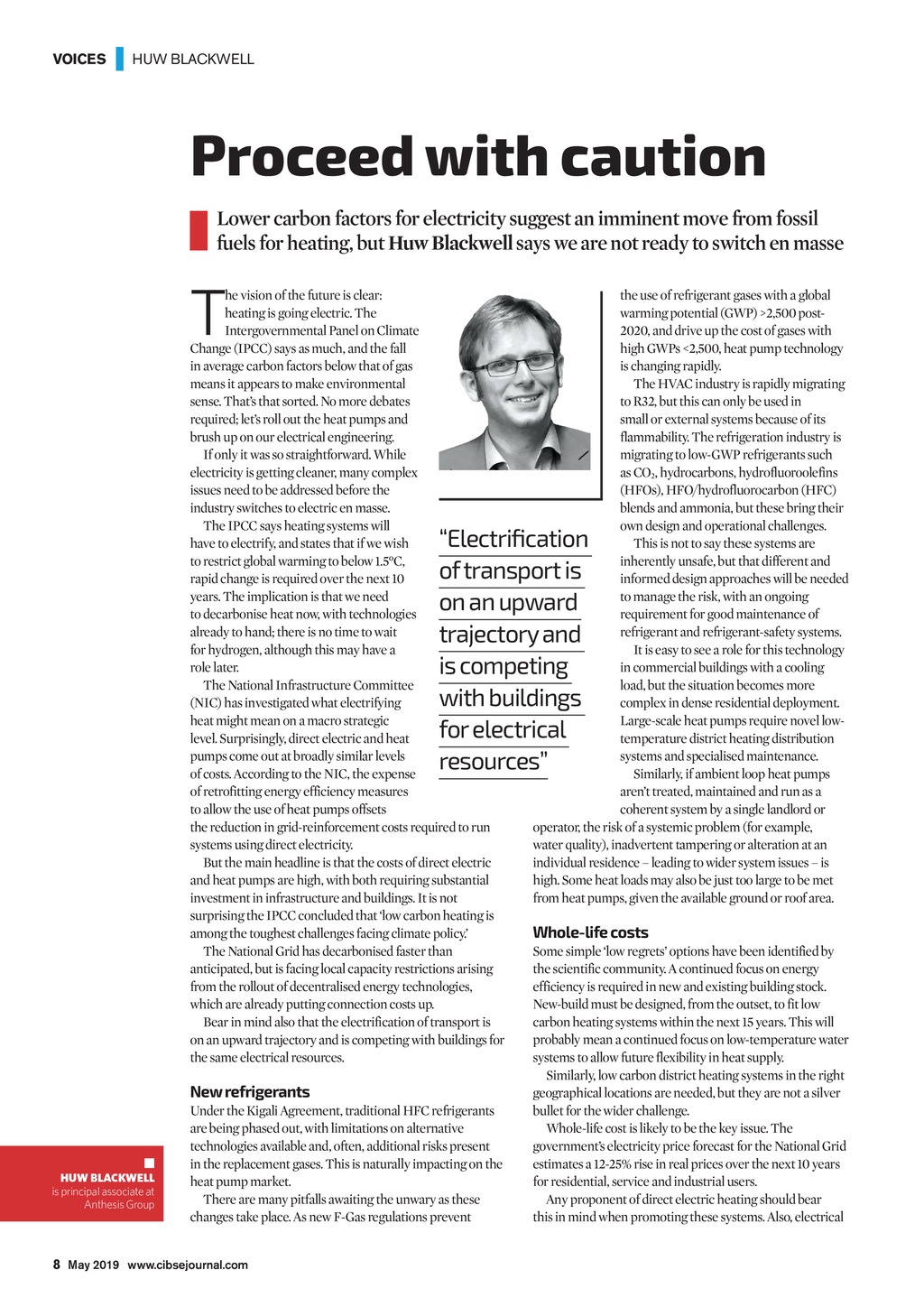




OICES | HUW BLACKWELL Proceed with caution Lower carbon factors for electricity suggest an imminent move from fossil fuels for heating, but Huw Blackwell says we are not ready to switch en masse T he vision of the future is clear: heating is going electric. The Intergovernmental Panel on Climate Change (IPCC) says as much, and the fall in average carbon factors below that of gas means it appears to make environmental sense. Thats that sorted. No more debates required; lets roll out the heat pumps and brush up on our electrical engineering. If only it was so straightforward. While electricity is getting cleaner, many complex issues need to be addressed before the industry switches to electric en masse. The IPCC says heating systems will have to electrify, and states that if we wish to restrict global warming to below 1.5C, rapid change is required over the next 10 years. The implication is that we need to decarbonise heat now, with technologies already to hand; there is no time to wait for hydrogen, although this may have a role later. The National Infrastructure Committee (NIC) has investigated what electrifying heat might mean on a macro strategic level. Surprisingly, direct electric and heat pumps come out at broadly similar levels of costs. According to the NIC, the expense of retrofitting energy efficiency measures to allow the use of heat pumps offsets the reduction in grid-reinforcement costs required to run systems using direct electricity. But the main headline is that the costs of direct electric and heat pumps are high, with both requiring substantial investment in infrastructure and buildings. It is not surprising the IPCC concluded that low carbon heating is among the toughest challenges facing climate policy. The National Grid has decarbonised faster than anticipated, but is facing local capacity restrictions arising from the rollout of decentralised energy technologies, which are already putting connection costs up. Bear in mind also that the electrification of transport is on an upward trajectory and is competing with buildings for the same electrical resources. the use of refrigerant gases with a global warming potential (GWP) >2,500 post2020, and drive up the cost of gases with high GWPs <2,500, heat pump technology is changing rapidly. The HVAC industry is rapidly migrating to R32, but this can only be used in small or external systems because of its flammability. The refrigeration industry is migrating to low-GWP refrigerants such as CO2, hydrocarbons, hydrofluoroolefins (HFOs), HFO/hydrofluorocarbon (HFC) blends and ammonia, but these bring their own design and operational challenges. This is not to say these systems are inherently unsafe, but that different and informed design approaches will be needed to manage the risk, with an ongoing requirement for good maintenance of refrigerant and refrigerant-safety systems. It is easy to see a role for this technology in commercial buildings with a cooling load, but the situation becomes more complex in dense residential deployment. Large-scale heat pumps require novel lowtemperature district heating distribution systems and specialised maintenance. Similarly, if ambient loop heat pumps arent treated, maintained and run as a coherent system by a single landlord or operator, the risk of a systemic problem (for example, water quality), inadvertent tampering or alteration at an individual residence leading to wider system issues is high. Some heat loads may also be just too large to be met from heat pumps, given the available ground or roof area. Electrification of transport is on an upward trajectory and is competing with buildings for electrical resources New refrigerants HUW BLACKWELL is principal associate at Anthesis Group Under the Kigali Agreement, traditional HFC refrigerants are being phased out, with limitations on alternative technologies available and, often, additional risks present in the replacement gases. This is naturally impacting on the heat pump market. There are many pitfalls awaiting the unwary as these changes take place. As new F-Gas regulations prevent Whole-life costs Some simple low regrets options have been identified by the scientific community. A continued focus on energy efficiency is required in new and existing building stock. New-build must be designed, from the outset, to fit low carbon heating systems within the next 15 years. This will probably mean a continued focus on low-temperature water systems to allow future flexibility in heat supply. Similarly, low carbon district heating systems in the right geographical locations are needed, but they are not a silver bullet for the wider challenge. Whole-life cost is likely to be the key issue. The governments electricity price forecast for the National Grid estimates a 12-25% rise in real prices over the next 10 years for residential, service and industrial users. Any proponent of direct electric heating should bear this in mind when promoting these systems. Also, electrical 8 May 2019 www.cibsejournal.com CIBSE May19 pp08-09 Huw Blackwel Supp.indd 8 26/04/2019 18:02